Reflecting the Female
 I only recently discovered the art of Tina Berning, thanks to that magical font of information: Pinterest. I love her technique – the use of mixed media, collage and ephemera as a base, the unfinished look of them – more than the subject, although ‘reflecting the female role in media is one of the core issues in her artistic work. Her early passion for editorial illustrataion led her to an intensive contemplation on the human figure.’ [Wikipedia]
I only recently discovered the art of Tina Berning, thanks to that magical font of information: Pinterest. I love her technique – the use of mixed media, collage and ephemera as a base, the unfinished look of them – more than the subject, although ‘reflecting the female role in media is one of the core issues in her artistic work. Her early passion for editorial illustrataion led her to an intensive contemplation on the human figure.’ [Wikipedia]
 Berning has been focused on drawing and illustration since 2000; she has been published widely, and has had numerous solo exhibitions. Her website doesn’t seem to hold much information on her, but there is plenty more gorgeous and inspiring work to browse through.
Berning has been focused on drawing and illustration since 2000; she has been published widely, and has had numerous solo exhibitions. Her website doesn’t seem to hold much information on her, but there is plenty more gorgeous and inspiring work to browse through.
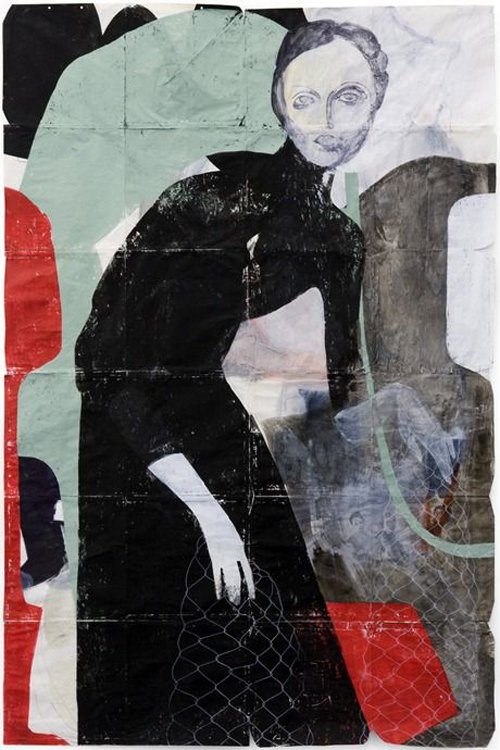
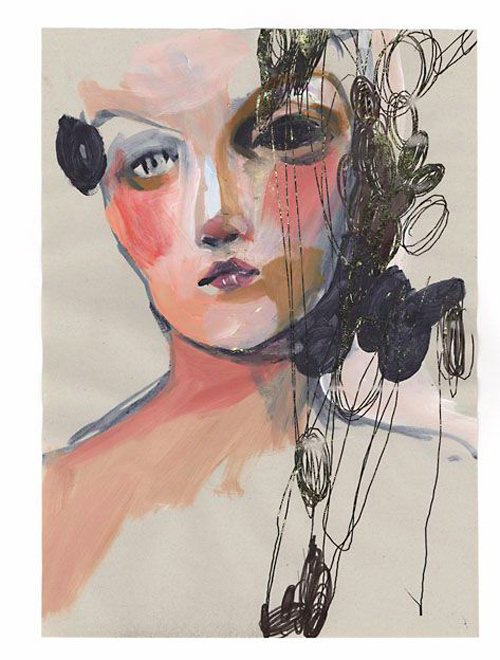
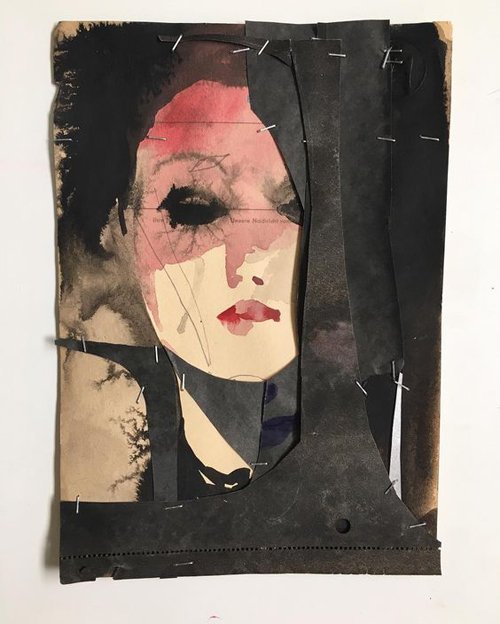

Decoding Thoughts
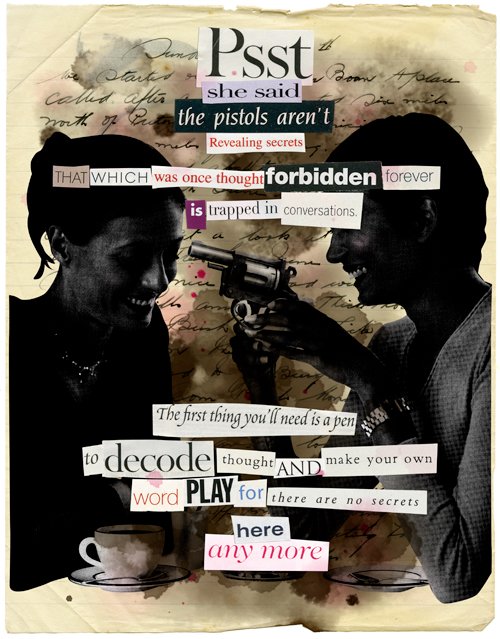 Psst She Said, Helena Turinski 2015Psst she said.
Psst She Said, Helena Turinski 2015Psst she said.
The Pistols aren’t revealing secrets.
That which was once thought forbidden forever is trapped in conversations.
The first thing you’ll need is a pen to decode thought
and make your own word play
for there are no secrets here any more.
I really love assembling my random poems. It’s such an exciting and serendipitous process that evolves rapidly as I snatch up cut-out words that seem to fit whatever I am weaving under my hand. I never know where a poem is going to go either. I haven’t actually ‘written’ any for a while because I have such a huge backlog of poems that I have yet to turn into collages.
The words obviously inform the pictures, but sometimes the pictures themselves add an extraordinary power to one’s perception of the poem, such as in this image. The women were cut out from some innocuous advertisement, although for what I can’t recall. The blackness of the figures adds such a sinister tone, especially with the highlighted white teeth, as does the gun pointed directly at the smiling woman’s head; the metaphors are obvious. The strange and stark contrasts make me chuckle – that’s what society is like sometimes – but we should never ignore the undercurrents.
Layering Dreams
 Always Inside Your Dreams; collage, found paper 240mm (w) x 350mm (h)Last year I took part in a group exhibition called Read What You Look At, at Brunswick Street Gallery in Fitzroy, Melbourne. Funnily, I hadn’t actually planned for it, but had seen a call for applications in the newsletter I receive from the gallery and thought the theme was singularly appropriate for one stream of my fine arts practice.
Always Inside Your Dreams; collage, found paper 240mm (w) x 350mm (h)Last year I took part in a group exhibition called Read What You Look At, at Brunswick Street Gallery in Fitzroy, Melbourne. Funnily, I hadn’t actually planned for it, but had seen a call for applications in the newsletter I receive from the gallery and thought the theme was singularly appropriate for one stream of my fine arts practice.
I have been working on what I call my ‘random poems’ for many years – ever since I finished art college (a frighteningly long time ago) – and they have developed quite a lot over the years. Some of them are traditional hard copy collages, assembled on antique and vintage paper dating from the 1860s–1950s, and others are original digital artworks that combine collage with ink on the same paper backgrounds.
 Labours With Ancient Goddess; original digital artwork; 192mm (w) x 321mm (h)Originally they were all traditional collages, but as I started working with these priceless pieces of crumbling ephemera, I was terrified of ruining or disintegrating them with real ink, so I started experimenting with digital ink. (Some viewers of the exhibition thought it was real ink, so I can plume myself on my success there!) Of course I have to scan everything in, which is a time-consuming although ultimately pleasurable process. But there is still a real charm in the haphazard and inappropriate sizing of the words in the hard copy collages, where conjunctions sometimes shout louder than nouns or adjectives.
Labours With Ancient Goddess; original digital artwork; 192mm (w) x 321mm (h)Originally they were all traditional collages, but as I started working with these priceless pieces of crumbling ephemera, I was terrified of ruining or disintegrating them with real ink, so I started experimenting with digital ink. (Some viewers of the exhibition thought it was real ink, so I can plume myself on my success there!) Of course I have to scan everything in, which is a time-consuming although ultimately pleasurable process. But there is still a real charm in the haphazard and inappropriate sizing of the words in the hard copy collages, where conjunctions sometimes shout louder than nouns or adjectives.
Along the way I also started playing with the effect of turning the cut paper images a stark black and white, for more impact and as a contrast to the coloured letters, and splashes of ink.
Read the original Artist’s Statement on Layering Dreams, or view the gallery.
Layering Dreams
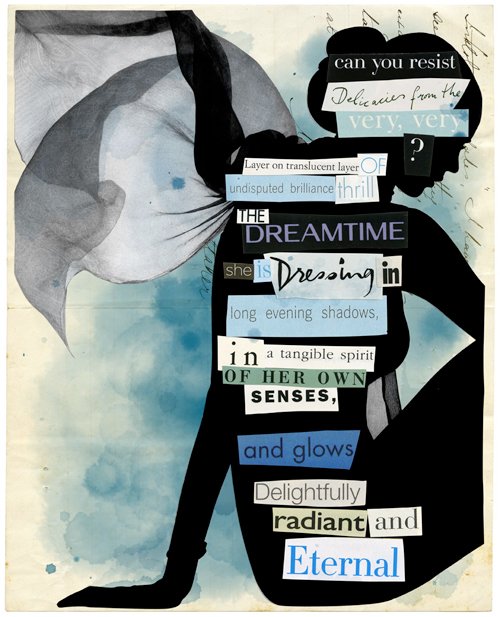 I am excited to share the news that I am taking part in a group exhibition at Brunswick Street Gallery called Read What You Look At, which opens this Friday night, and runs for two weeks.
I am excited to share the news that I am taking part in a group exhibition at Brunswick Street Gallery called Read What You Look At, which opens this Friday night, and runs for two weeks.
Although it is not my first group exhibition, it is the biggest one I’m showing in, with fourteen pieces of my ‘random poetry’ mixed-media collages on view. The series is entitled Layering Dreams, and is – you guessed it – all about dreams, sleeping, and waking.
Here is an abridged version of my artist’s statement:
From a very young age, I was captivated with telling stories through both words and pictures, often drawing and writing on found paper. At art college after studying the Dadaists, I became interested in writing poetry by reassembling random words. Recycling my magazine collection, I created a pool from which I could pull words to compile into ‘random poems’.
Always interested in dreams, and the surrealism intertwined with hidden meanings, this method of writing poetry appealed to me. Naturally, I choose words that I find appealing, but sometimes I deliberately choose ones that I don’t. This strange combination contributes to the elusive mood of Layering Dreams, often with unexpected results.
 Sometimes a poem just starts with two or three words, and I slowly build on those. The poems are engaging and easy to read not only because of their brevity, but because of how they look. The fonts and colours culled from so many different sources interact with one another visually, encouraging the viewer to also ‘look at what they read’.
Sometimes a poem just starts with two or three words, and I slowly build on those. The poems are engaging and easy to read not only because of their brevity, but because of how they look. The fonts and colours culled from so many different sources interact with one another visually, encouraging the viewer to also ‘look at what they read’.
Returning to my roots of acquiring used paper (I’d pinch my sisters’ papers from their school folders!), I’ve sourced antique papers from the late nineteenth century to the 1950s, to use as supports for the collages. As well as traditional (hard copy) collages using only words, I also create digital works, combining scanned words and images cut from magazines with digital ink.
These many layers of ephemera, words, and pictures combine to evoke the otherworldly nature of dreams.
If you happen to be in Melbourne, I’d love for you to come and check them out in person!
Collage Experiments
 Black Clouds SurroundI have always enjoyed collage illustration, and over the past year or two have been developing the style of my ‘random poems’, incorporating watercolour (simulated in Photoshop) with the collage, on a vintage paper base.
Black Clouds SurroundI have always enjoyed collage illustration, and over the past year or two have been developing the style of my ‘random poems’, incorporating watercolour (simulated in Photoshop) with the collage, on a vintage paper base.
Here are a couple of recent experiments in pure illustration (that is, no dada-style or random poetry as I call it). The illustrations about different aspects of mental health are portfolio samples, the concepts for them developing and fermenting in my head as I leafed through magazines, cutting out likely photographs, amputating an arm here, a head there. They were very fun to assemble – there is often an element of humour in my work (black or otherwise), and so much potential for it in this kind of collage.
 Don’t Be Who You Aren’tI am also experimenting further with more traditional pen and ink incorporated with collage. There are pros and cons to both traditional and digital illustration, but I enjoy the different freedoms of both.
Don’t Be Who You Aren’tI am also experimenting further with more traditional pen and ink incorporated with collage. There are pros and cons to both traditional and digital illustration, but I enjoy the different freedoms of both.


